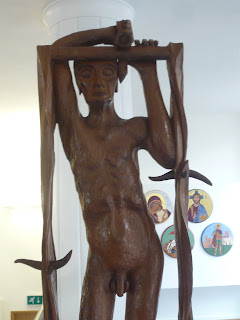Saturday 25th August
A hot shower, cooked breakfast and good conversation at the Rectory where I staying provide a great beginning to a day that will see torrential showers and the resulting quagmire.
John Polkinghorne highlighted the particularity of our universe by means of the specific conditions which created carbon. The universe was pregnant with rich potentiality and possibility from the very beginning but in very short spaces of time finely tuned chemical reactions were required for life to emerge; slight differences would have meant that the carbon necessary for life could not have developed. At the opposite extreme, a very large universe is required for life to emerge and our universe is sufficiently large. The particular conditions for life met within our universe point to a fine tuning of the laws of nature - creation. This is an enduring condition with new things coming into being under particular circumstances at the edge of chaos where life is neither too ordered or too haphazard. This is the snake in Eden – evolution comes at a cost; ragged edges and blind alleys. Creation has to exist at a distance from the Creator for free will to genuinely operate. Therefore, the mutation of cells at the edge of chaos has a shadow side; cells can mutate in ways that are malignant (cancerous) as well as benign. This is the inevitable cost of a world able to make itself through an evolving chemistry of life.
The universe is expanding and cooling; the eventual result will be its end in futility and decay. “The more I understand the universe, the more it seems pointless,” says Stephen Weinberg. Christianity speaks, however, of the faithfulness of the Creator and a destiny after death. Continuity and discontinuity is therefore implied. The constantly changing atoms of our bodies carry the information, pattern or structure of our character and memories. This pattern is the real person and could be preserved in the divine mind to be resurrected in the different matter of a future different body and world. New matter transformed from the old. Jesus’ resurrection is the seed event for this possibility and sacraments are occasions when the veil between this world and the next is thinned.
Based on this I write:
In the tension of the now and not yet,
between order and disintegration,
between anarchy and regimentation,
in between, the broken middle,
the crack where the light gets in,
is the edge of chaos where life evolves,
where change occurs not free of cost –
ragged edges, blind alleys, the snake in Eden –
evolution into consciousness, falling up.
Diarmaid MacCulloch spoke about his attempt to show the wider public the importance of Church history by reshaping the way the story is told. Christianity is a personality cult as Jesus is the one constant in the diversity of the faith. Christians tell stories about Jesus in which audacious claims are made about his divinity and continuing presence. The Bible is a diverse library of books. The ideas at the heart of all world religions are flexible and change as the religions mutate and change to survive.
Christianity has unstable roots are it has two different sources; Judaism and Hellenism. Judaism speaks of a passionate, angry God while the Greeks spoke of a perfect, unchanging God. The first four centuries of Christianity are trying to reconcile these two dichotomies. Christianity, therefore, is essentially a question. A key moment is this debate comes with the Council of Calcedon in 451CE. The compromise worked out there has come to characterise Roman Catholic, Protestant and Orthodox expressions of the faith but at the time it was a disaster as it was not accepted by two-thirds of the Church. It was only because of the growth of Islam and its later development of a missionary aspect which caused the fading of the influence and ideas of that two-thirds Church which had rejected Calcedon. This was historical accident which could easily have been different if the influence of the Church of the East had been maintained. Historically, it is clear that the Church has always been diverse.
McCulloch was asked about accessible Early Church histories and didn’t provide much in the way of ideas but could have pointed to the excellent Video Timeline Project by Tim Hull at St John’s Nottingham which was being promoted in G-Source.
The rains came while Pádraig Ó Tuama, who seems to be the unofficial poet laureate of Greenbelt, was entertaining us with lengthy comedic introductions to the short depressive ‘Reading from the Book of Exile’ poems (his description). There were more poetic songs from Bruce Cockburn in an unplugged session at the Big Top. “I’m thinking ‘bout eternity. Some kind of ecstasy got a hold on me,” lines from ‘Wondering where the Lions are’, which could sum up the GB12 content thus far.
My own poem seems to have reached what may be a realised final form:
There is no culmination, no end to need or greed,
no resolution - the need to dim the lights never ceases.
Your people age and fail and demand unless I cry,
‘No more, no more,’ and die. When will the culmination come?
When needs are met? When work ceases? When demands are done?
Always more, more, more. Human selfishness calls love without limits
into being –the tap of love turned full on – ever-flowing.
No end, no culmination, no resolution.
Take up the cross, become the host;
continually broken, consumed and re-membered.
---------------------------------------------------------------------------------------------











































































